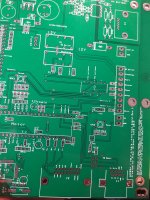Lebowski said:Dont thjnk parallelling two output stages is a problem, but I would definitely use all 6 current sensors then ! You can add the current sensor outputs using resistors.
Hm... so i could just connect sensors in the same order they are connected to outputs. I.e. sensor A1 of one IPM would be parallel with sensor A2 on the other IPM and same for sensors on phases B and C. Where do the resistors come in?
See here i already use Volt connector J1 so sensors could be directly paralleled. Do you think i would have to add anything?


